
Elisabetta Sirani stands as a remarkable figure in the landscape of 17th-century Italian art. A prominent painter and printmaker of the Baroque period, she achieved extraordinary fame and success within a tragically short lifespan. Born in Bologna on January 8, 1638, and dying in the same city on August 28, 1665, Sirani navigated the male-dominated art world with exceptional skill, prolific output, and entrepreneurial spirit, leaving behind a legacy that continues to fascinate art historians and admirers alike. Her work, characterized by technical virtuosity, emotional depth, and often a focus on strong female protagonists, secured her place as one of Bologna's most celebrated artists.
Artistic Beginnings in a Painter's Household
Elisabetta Sirani's immersion in the art world began at birth. She was the eldest of four children born to Giovanni Andrea Sirani, a respected painter of the Bolognese School and a primary assistant to the renowned master Guido Reni. Giovanni Andrea was not only a painter but also an art dealer and ran a bustling workshop. This environment provided Elisabetta with unparalleled access to artistic training and the workings of the art market from a very young age.
Initially, her father was hesitant to train her formally in painting, perhaps due to prevailing societal norms regarding women's roles. However, her prodigious talent became undeniable. Encouragement came from a key figure in Bolognese art circles, Count Carlo Cesare Malvasia. A noted art historian, biographer, and friend of the Sirani family, Malvasia recognized Elisabetta's potential and persuaded her father to provide her with rigorous instruction. Malvasia would later become her staunch supporter and document her life and work in his influential book "Felsina Pittrice" (1678).
Under her father's tutelage, Elisabetta quickly mastered the fundamentals of drawing, composition, and painting techniques prevalent in the Bolognese school, which emphasized strong drawing skills and classical ideals, often blended with Baroque dynamism. She absorbed the stylistic lessons inherited from Guido Reni through her father, evident in the graceful figures and often harmonious compositions found in some of her works. However, she rapidly developed her own distinct artistic voice.
A Rapid Ascent to Fame
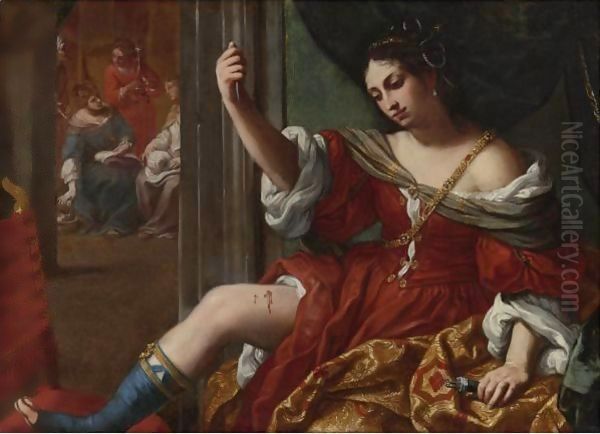
By the age of 17, Elisabetta Sirani was already working as an independent artist, a remarkable achievement for anyone, let alone a young woman in the 17th century. Her talent was immediately recognized. When her father was afflicted with gout, which severely hampered his ability to paint, Elisabetta, still a teenager, effectively took over the management of the family workshop around 1655. This responsibility included not only producing her own commissioned works but also supporting her family financially and overseeing the training of her younger siblings, Barbara and Anna Maria Sirani, who also became painters.
Her reputation soared rapidly within Bologna and beyond. She became known for her incredible speed and efficiency, reportedly able to complete complex compositions with remarkable swiftness. This skill was not merely a matter of efficiency; it became a public spectacle. To counter skepticism, common at the time, that a woman could possess such artistic prowess or that her prolific output was solely her own, Sirani often painted before audiences in her studio. Patrons and dignitaries would watch, amazed, as she brought canvases to life with confident, rapid brushstrokes.
Her clientele grew to include noble families, wealthy merchants, clergy, and even royalty. She received prestigious commissions for altarpieces for churches in Bologna and surrounding areas, as well as historical and mythological scenes, allegories, and portraits for private collectors. Her fame spread throughout Italy and reached other parts of Europe, with collectors eagerly seeking her work.
Artistic Style: Grace, Drama, and Female Power
Elisabetta Sirani's style is firmly rooted in the Bolognese Baroque tradition, yet it possesses unique characteristics that distinguish her work. The influence of Guido Reni, transmitted through her father Giovanni Andrea Sirani, is apparent in the classical elegance of some figures, the clarity of composition, and a certain idealized beauty. However, Sirani often infused her paintings with a greater sense of immediacy, emotional intensity, and dramatic flair than typically found in Reni's later works.
A key element of her style is her adept use of chiaroscuro – the dramatic interplay of light and shadow. While perhaps not as starkly contrasted as the works of Caravaggio, whose influence permeated Italian art, Sirani employed strong lighting to model forms, create focal points, and enhance the emotional impact of her scenes. Her brushwork is often described as fluid, confident, and energetic, contributing to the vitality of her paintings. She possessed a remarkable ability to render textures, from shimmering silks to soft flesh, with convincing realism.
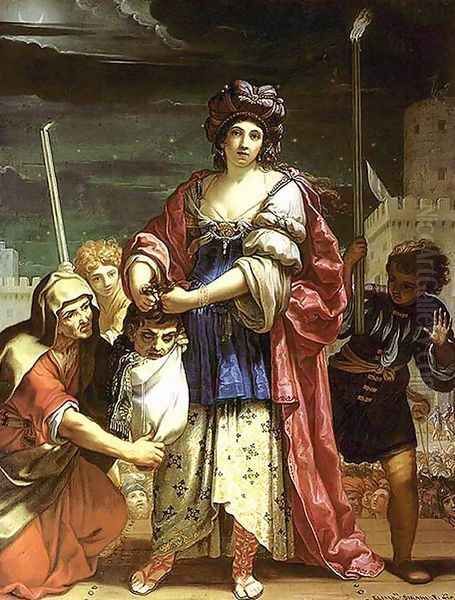
Sirani excelled across various genres. Her religious paintings often convey deep piety and pathos, treating traditional subjects with sensitivity and originality. Her mythological and historical scenes frequently focus on dramatic moments and complex narratives. She was particularly noted for her depictions of female heroines from history, mythology, and the Bible. Figures like Judith, Portia, Timoclea, Cleopatra, and various female saints appear repeatedly in her oeuvre, often portrayed not as passive victims but as figures of strength, intellect, virtue, or decisive action. This focus has led modern scholars to view her as an artist who consciously explored themes of female agency and power within the constraints of her time.
Representative Masterworks
Elisabetta Sirani's prolific output, estimated at over 200 paintings, drawings, and etchings in just over a decade of professional work, includes numerous significant pieces. Among her most celebrated works are:
_Portia Wounding Her Thigh_ (1664): This painting depicts the Roman heroine Portia, wife of Brutus, demonstrating her resolve and worthiness to share in her husband's conspiracy against Caesar by secretly inflicting a wound upon herself. Sirani captures the moment of quiet determination and physical pain, highlighting Portia's stoicism and courage. The composition is focused, the lighting dramatic, emphasizing the intimate yet heroic nature of the act.
_Judith with the Head of Holofernes_ (c. 1658): A popular subject in Baroque art, Sirani painted several versions of the biblical story of Judith beheading the Assyrian general Holofernes. Unlike some contemporary depictions that emphasize the gruesome violence, Sirani often focuses on Judith's calm resolve, piety, or the psychological aftermath of the act. Her Judith is typically portrayed as both beautiful and formidable, a virtuous heroine acting to save her people. This theme resonates with similar powerful depictions by her female contemporary, Artemisia Gentileschi, though their interpretations often differ in emotional tone.
_Timoclea Killing the Captain of Alexander the Great_ (1659): This dynamic composition illustrates a story from Plutarch where Timoclea, after being violated by one of Alexander's Thracian captains, tricks him into looking down a well and then pushes him in, pelting him with stones. Sirani captures the peak of the action, emphasizing Timoclea's righteous fury and physical strength. It is another example of her interest in depicting assertive female protagonists from classical antiquity.
_The Baptism of Christ_ (1658): Commissioned for the Certosa di Bologna (Carthusian Monastery), this large altarpiece demonstrates Sirani's skill in handling complex multi-figure compositions and conveying profound religious sentiment. The work was highly praised and solidified her reputation as a painter capable of undertaking major public commissions.
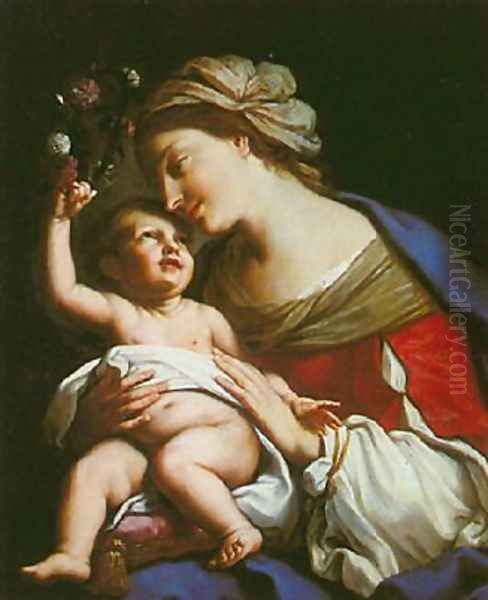
_Virgin and Child_ (various versions): Sirani painted numerous variations of the Madonna and Child theme, often imbued with tender intimacy and maternal warmth. These works showcase her ability to blend idealized beauty, influenced by Reni, with a palpable sense of human emotion and connection between the figures. One notable version from 1663, now in the National Museum of Women in the Arts, Washington D.C., is considered a masterpiece of her mature style.
_Self-Portrait as the Allegory of Painting_ (1658): In this work, Sirani presents herself not just as a painter but as the personification of Painting itself ('La Pittura'). This was a bold statement, aligning herself with a tradition often reserved for male artists and asserting her identity and status within the art world. She depicts herself elegantly dressed, holding the tools of her trade, gazing confidently at the viewer.
The Academy for Women Artists
Beyond her own prolific artistic output, Elisabetta Sirani made a significant contribution to the history of women in art through her role as an educator. She established and ran what is considered one of the earliest, if not the first, dedicated art academies for women in Europe, operating out of her family workshop. In an era when formal artistic training for women was scarce and often limited to convent workshops or informal instruction within family studios, Sirani provided professional-level training to numerous young women.
Her students included her own sisters, Barbara Sirani and Anna Maria Sirani, who went on to have careers as painters. Other documented pupils include Veronica Fontana, who became a noted printmaker, Ginevra Cantofoli (also considered a contemporary and sometimes rival), Lucrezia Scarfaglia, and others mentioned by Malvasia, such as Elena Maria Panzacchi, Teresa Coriolano, and Agostina Tardelli. While the careers of some of these women are less documented than Sirani's, the existence of this school highlights Sirani's commitment to fostering female talent and creating opportunities for women in the professional art world of Bologna.
Her teaching activities further solidified her central role in the Bolognese art scene and demonstrated her entrepreneurial acumen. The workshop became a hub of artistic activity, attracting commissions and further enhancing the Sirani family's reputation.
Contemporaries and the Bolognese Art Scene
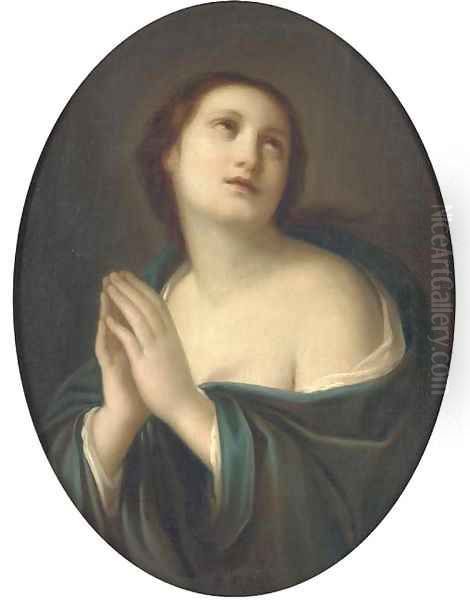
Elisabetta Sirani worked during a vibrant period in Bolognese art history. The legacy of the Carracci family (Ludovico, Agostino, and Annibale Carracci), who had revitalized painting in Bologna at the end of the 16th century, was still influential. The dominant figure during her formative years was Guido Reni, whose classical Baroque style set a standard for many artists in the city. Sirani's art must be understood within this context, engaging with Reni's elegance while also responding to other trends.
Other significant Bolognese painters active during or overlapping with Sirani's lifetime included:
Guercino (Giovanni Francesco Barbieri): An older contemporary known for his dynamic compositions and rich chiaroscuro, representing another major strand of the Bolognese Baroque.
Domenichino (Domenico Zampieri): Though primarily active earlier, his classically inspired works remained influential.
Simone Cantarini (Il Pesarese): Another pupil of Reni, known for his sensitive etchings and paintings, sometimes seen as a rival to Reni and a contemporary influence.
Lorenzo Pasinelli: A slightly younger contemporary who became a leading figure in Bolognese painting after Sirani's death.
Carlo Cignani: Another important Bolognese painter whose career extended into the later Baroque period.
Ginevra Cantofoli: A female contemporary painter, sometimes listed as Sirani's student but also considered an independent artist and potential rival, known for her allegorical and religious subjects.
Beyond Bologna, Sirani's work can be contextualized alongside other prominent Italian Baroque artists. Her focus on strong female characters invites comparison with Artemisia Gentileschi, the celebrated follower of Caravaggio, although Sirani's style generally adheres more closely to the Bolognese blend of classicism and Baroque dynamism. Earlier Bolognese women artists like Lavinia Fontana had paved the way for professional female painters, establishing precedents that Sirani built upon. Sirani's success demonstrates that Bologna, perhaps more than other Italian cities at the time, offered significant opportunities for women artists to achieve professional recognition.
A Mysterious End and Enduring Legacy
Elisabetta Sirani's brilliant career was cut tragically short. In August 1665, she died suddenly at the age of 27 after a brief illness involving severe stomach pain. Her untimely death shocked Bologna and fueled immediate speculation. Rumors quickly spread that she had been poisoned, possibly out of jealousy, by a maidservant named Lucia Tolomelli. The suspicion was strong enough that Tolomelli was charged and put on trial, although she was later acquitted (or the charges were dropped at the request of Giovanni Andrea Sirani).
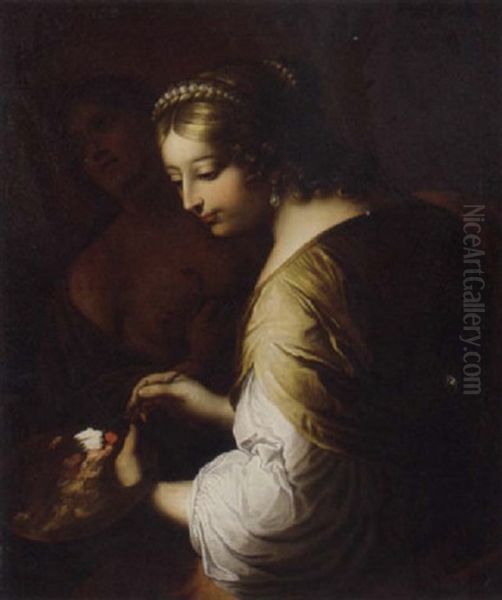
An autopsy was performed, a rare procedure at the time, indicating the seriousness with which her death was viewed. The physicians reported finding perforations in her stomach. While the poisoning theory persisted for centuries, modern medical interpretations of the autopsy report suggest that Sirani likely died from natural causes, specifically a ruptured peptic ulcer leading to peritonitis. The intense stress of managing the workshop, supporting her family, meeting demanding commission deadlines, and constantly proving herself in a male-dominated field may have contributed to the condition.
The city of Bologna mourned her deeply. She was given an extraordinarily grand funeral, held at the Basilica of San Domenico. The outpouring of grief and the scale of the ceremony, comparable to that held for Guido Reni years earlier, underscored the high esteem in which she was held. She was initially buried in the Guidotti Chapel of the Basilica, but later her remains were moved to the Rosary Chapel within the same church, where she was laid to rest beside Guido Reni – a symbolic final pairing of the master and the exceptionally talented artist who followed in his tradition yet forged her own path. Count Carlo Cesare Malvasia ensured her story and achievements were recorded for posterity.
Elisabetta Sirani's legacy is multifaceted. She left behind a substantial body of high-quality work produced in just over a decade. She demonstrated that a woman could run a successful, independent workshop and achieve international fame based on her artistic merit. Her focus on capable, heroic female figures offered alternative representations of women within Baroque art. Furthermore, her pioneering role as an educator who actively trained other women artists had a lasting impact, contributing to the visibility and professionalization of female artists in Bologna and beyond. Today, her paintings are held in major museums worldwide, and she is recognized as one of the most important and talented artists – regardless of gender – of the Italian Baroque period.